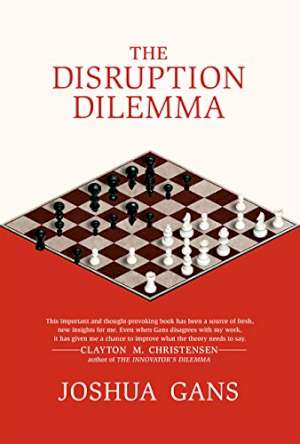09 November 2016
The Disruption Dilemma
Joshua Gans
2016, MIT Press, 176 pages,
ISBN 9780262533621
Reviewer: David Lancefield, Partner, PwC

Business is littered with the word ‘disruption’. Overly-used and misunderstood, it has lost its meaning and caused too much anxiety and paranoia, argues Professor Joshua Gans of the University of Toronto. Anything that involves change or innovation falls under the disruption umbrella. Everyone should be disruptive. As result, there are too many distractions, and mistakes. And the source of the term, in Professor Clayton Christensen’s seminal book The Innovator’s Dilemma, has been widely criticised, spawning numerous management articles over the last decade. Gans reassess the basis, evidence and application of the D-word, concluding that fearful executives should ‘calm down’, but not relax about disruption.
Disruption happens when new entrants offer lower value products that erode the position of incumbents who continue to serve traditional customers. The dilemma refers to whether they should continue with the practices that led to their success, or change before failing. Too late, and they will face extinction; too early they will reduce their commercial performance by accelerating the ‘replacement effect’. This is one of the hardest trade-offs facing businesses: build in more resilience against disruption and you’ll sacrifice short-term profitability, and market leadership.
The Disruption Dilemma is a short book, offering a thorough and relentless critique of Christensen’s concept and research. At times, I wondered whether there was enough for a book, even though it is extensively researched. He recognises that he hasn’t been pure in applying a scientific method, using examples to ‘motivate, speculate and provoke thought.’ But this is a thoughtful contribution nevertheless.
Gans is rare in using and combining economics and management science; most academics stick to one or the other. The quotes on the front and covers from the likes of Professors Rebecca Henderson, Susan Athey and Erik Brynjolfsson show that he is highly respected and liked by his peers. Indeed it says a lot about both Gans and Christensen that the latter offers a humble quote.
He writes beautifully. Short, sharp sentences are a pleasure to read; at times it feels like I am having a conversation with him. He uses clever hooks at the beginning of chapters to entice you in, and then provides helpful summaries at the end of each chapter. The structure is very intuitive – from the definition to the sources of disruption, then predicting, managing and insuring against disruption, before concluding with views on how disruption should be managed in business. And he injects some humour too. It’s certainly rare to see a Star Wars quote in such an economics or business book!
I would be surprised if this becomes a ‘popular’ business book in New York Times best seller lists, however. His deep interrogation of the classic disruption case studies (Encylopedia Britannica, Blockbuster, Apple and more) offers new and surprising insights, leaving me feeling that his target audience is fellow academics. Business leaders may want to see more prescription as to what they do or stop doing too.
He starts with a clear definition of disruption then consolidates all of the thinkers before and after Christensen, starting with Schumpeter’s ‘gale of creative disruption’. The core of his argument is that businesses need to consider both the demand (driven by customers) and supply side (focusing on the architecture of the company) disruption. He challenges the conventional wisdom that companies should set up independent internal units, with the space and capital to innovate away from the traditional business. There is little evidence to show this works. Instead he there are important complementary assets which can help companies ride out disruptive events that too many companies ignore at their cost later on, when they want to re-integrate these separate units. Out of control, though, they need to double up on investments or acquire new entrants.
He avoids the journalistic squabble between Christensen and Lepore about the validity of the disruption hypothesis, which is a pity. And it would have been would have been refreshing to have seen some new examples outside the typical US tech, media and communications examples we see in books like these. I was looking for a little more prescription at the end and so I felt the book did not quite deliver on the promise on the back flap regarding the ‘full range of actions’ business can take.
Nevertheless this book is a welcome addition: Gans gives more colour, nuance and depth to the concept and application than any other book or article on this topic I’ve read. It will give business leaders confidence that disruption can be managed, using a wider range of levers than perhaps they thought without suggesting it will be easy. Others will want to build from this, perhaps tackling the hardest question: how can companies be innovative, efficient and less prone to disruption in both the short- and long-run? Now that would solve the disruption dilemma facing many business leaders.
